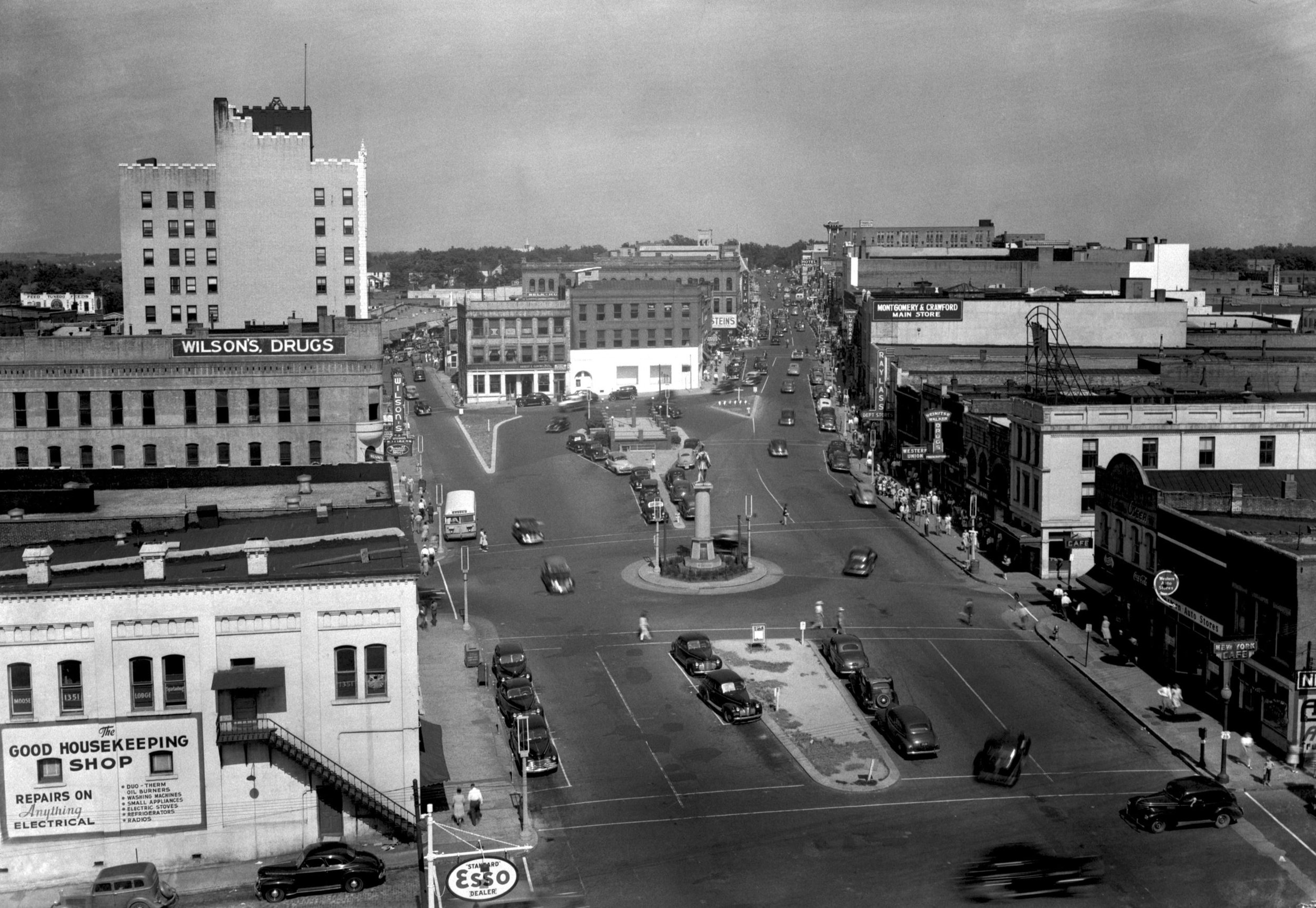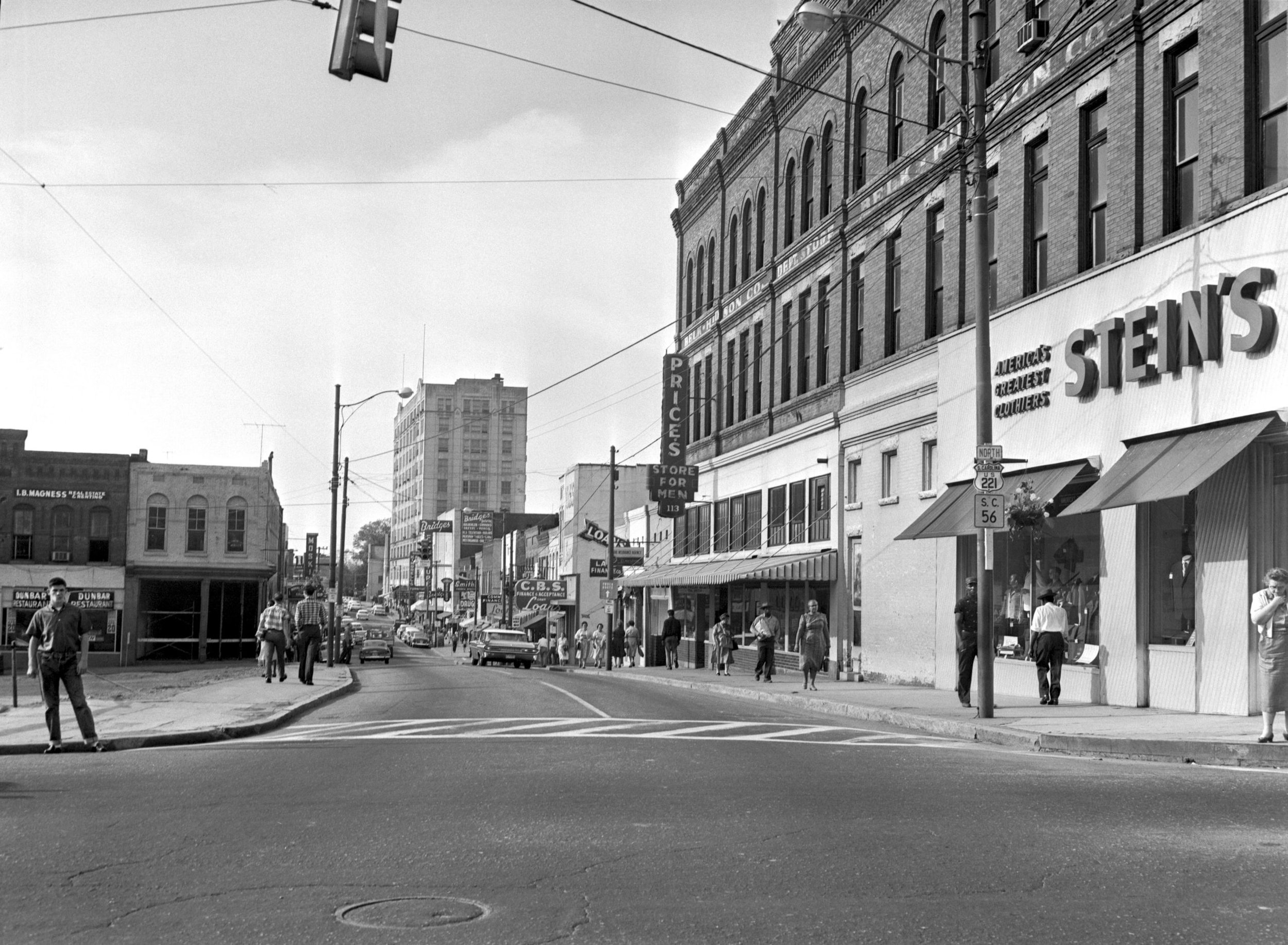Daniel Morgan Square, Through the Decades
From trolley tracks to bus shelters, a sea of asphalt to shaded pedestrian spaces, Daniel Morgan Square has experienced several changes over the past century. We looked back on over 100 years of downtown changes, decade by decade.
Long before the City of Spartanburg's incorporation on December 17th, 1831, Morgan Square was a hub of activity downtown. The first courthouse and jail- and the first foundations of local government- were constructed in 1785, with businesses gathering around these buildings and the square.
(For more history on downtown's early foundations and evolutions of government buildings, check out this two-part podcast episode from the City of Spartanburg: Episode One and Episode Two.)
In this article, we'll be focusing on Morgan Square itself, the central themes of each decade's version of this central gathering space, and the buildings that still remain through the most recent century of changes.
1890s-1910s
While Morgan Square was a central gathering place long before this time period, very little photo evidence exists or remains. The fourth courthouse in Spartanburg's history was built in 1891, but before that, the second and third courthouses were located on the Square itself, at Magnolia Street. Several large buildings at the foot of the square, namely the Spartan Inn (shown below) and the Opera House, were hubs of activity, government, and entertainment. The Spartan Inn was originally built as the Merchant's Hotel in 1880, and held businesses on the ground floor. It burned in April 1910, and the Cleveland Hotel was later built on its site. The Masonic Temple stands today at the former site of the Opera House. (Photos from 1906 and the 1890s, respectively.)
1920s
Trolley lines have arrived downtown, and were a popular mode of transportation for both work and pleasure. The streets are abuzz with pedestrians, personal cars, trolleys, cyclists, and a few remaining horses. At this point in time, a cannon, cannonballs, and a fence surrounded General Daniel Morgan's statue, but were later melted down in the war.
1930s-1940s
In the thirties and forties, (shown respectively below,) not much changed in Morgan Square's layout or central uses, aside from a trolley stop hub at the top of the square which became a bandstand. Subtle alterations were made to parking designations and traffic flow.
1950s
In the fifties, the block of buildings at the top of Morgan Square was leveled to later expand North Church Street, shown mid-demolition in this aerial view of West Main Street. Church Street facing North is shown in the second photo, before widening into a state highway around 1960.
The Montgomery Building stands in the distance, and the row of small buildings to the left would later be demolished as well. The Palmetto Building to the right still stands today, although small businesses line the ground floor instead of department stores. Outdoor gathering spaces were nearly nonexistent at this timeframe, with an emphasis on transportation.
1960s
1960s
If you look at this photo and think how terrifying it would be to cross eight lanes of traffic on West Main Street, then you're not alone. In the sixties, a parking lot was added along the South side of West Main Street, but was not pedestrian friendly at all. The theme of the time was convenience, but did not encourage downtown visitors to stroll from business to business. Daniel Morgan's statue was relocated to the top of the square.
1970s-1980s
Main Street Mall
As shopping centers and strip malls increased in popularity throughout the seventies, city leaders looked to transform downtown into a pedestrian shopping destination.
East Main Street, from Church Street to Converse Street, was closed to cars and bricked over. Known as the "Main Street Mall," this stretch of pedestrian- and cyclist-friendly downtown lasted from 1974-1989.While not part of Morgan Square, (nor overly successful in the long run,) this large-scale renovation of downtown shows a return to the principals of walkability and a focus on pedestrian safety. Much of the Main Street Mall's level of success lies in the mindset of the time and the popularity of shopping malls. Today, downtowns are seeing a resurgence as the center of activity, entertainment, and commerce.
1990s-2010s
While East Main Street saw several large changes through the seventies and eighties, Morgan Square and its surrounding streets were not without alterations as well. The City underwent multiple streetscaping projects through 2015-2016, on Magnolia Street, East Main Street, and Wall Street, ranging from widening sidewalks and replanting trees, to closing streets completely.
These two photos show Wall Street looking North, in 1985 and 2020, before and after the streetscaping project. The project transformed the little-used service road into a "festival street," which is closed to vehicular traffic and able to be used for businesses' events, artists' pop-ups, outdoor dining, and more.
(1985 Photo courtesy Nick Trainor.)
Standing the Test of Time
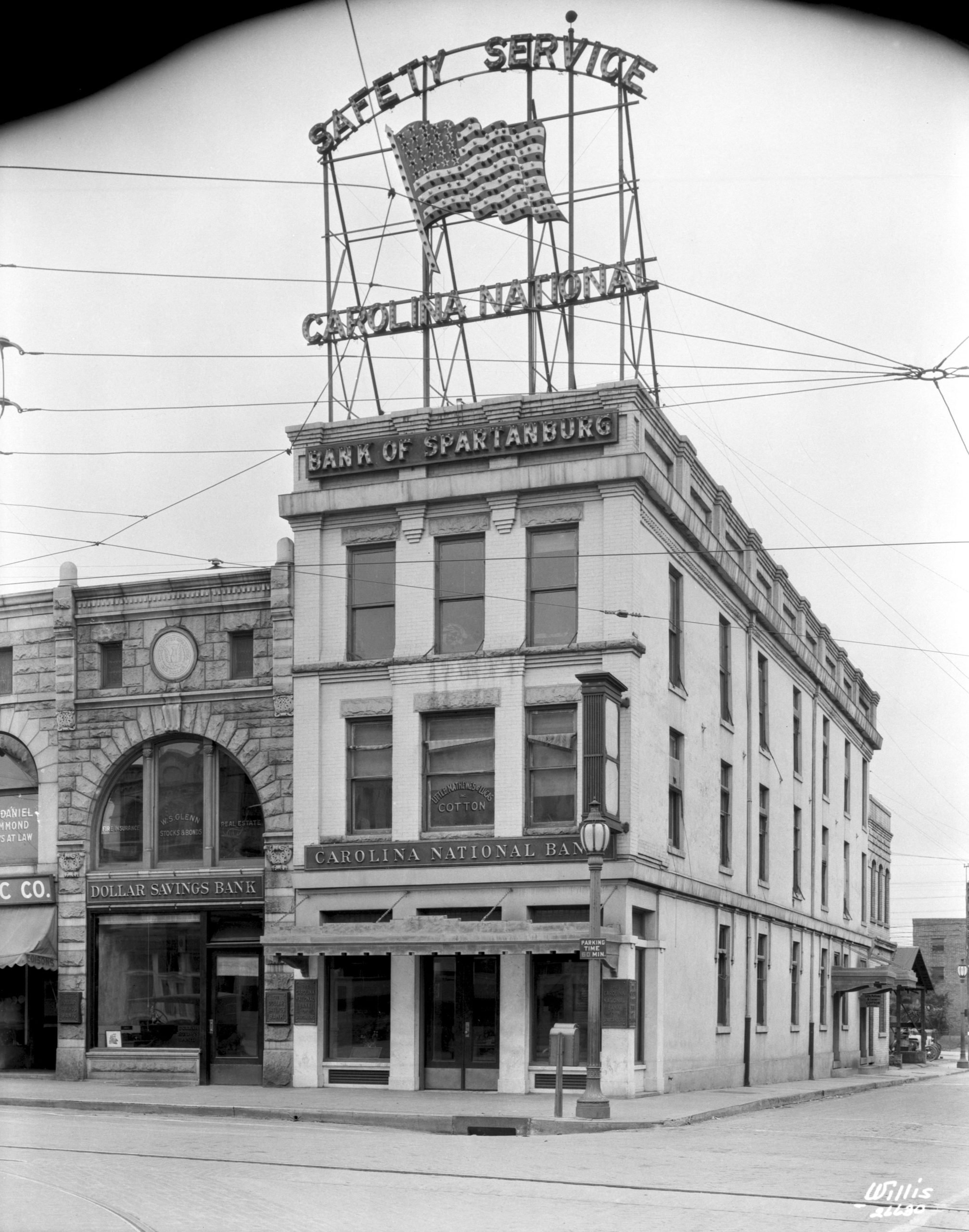
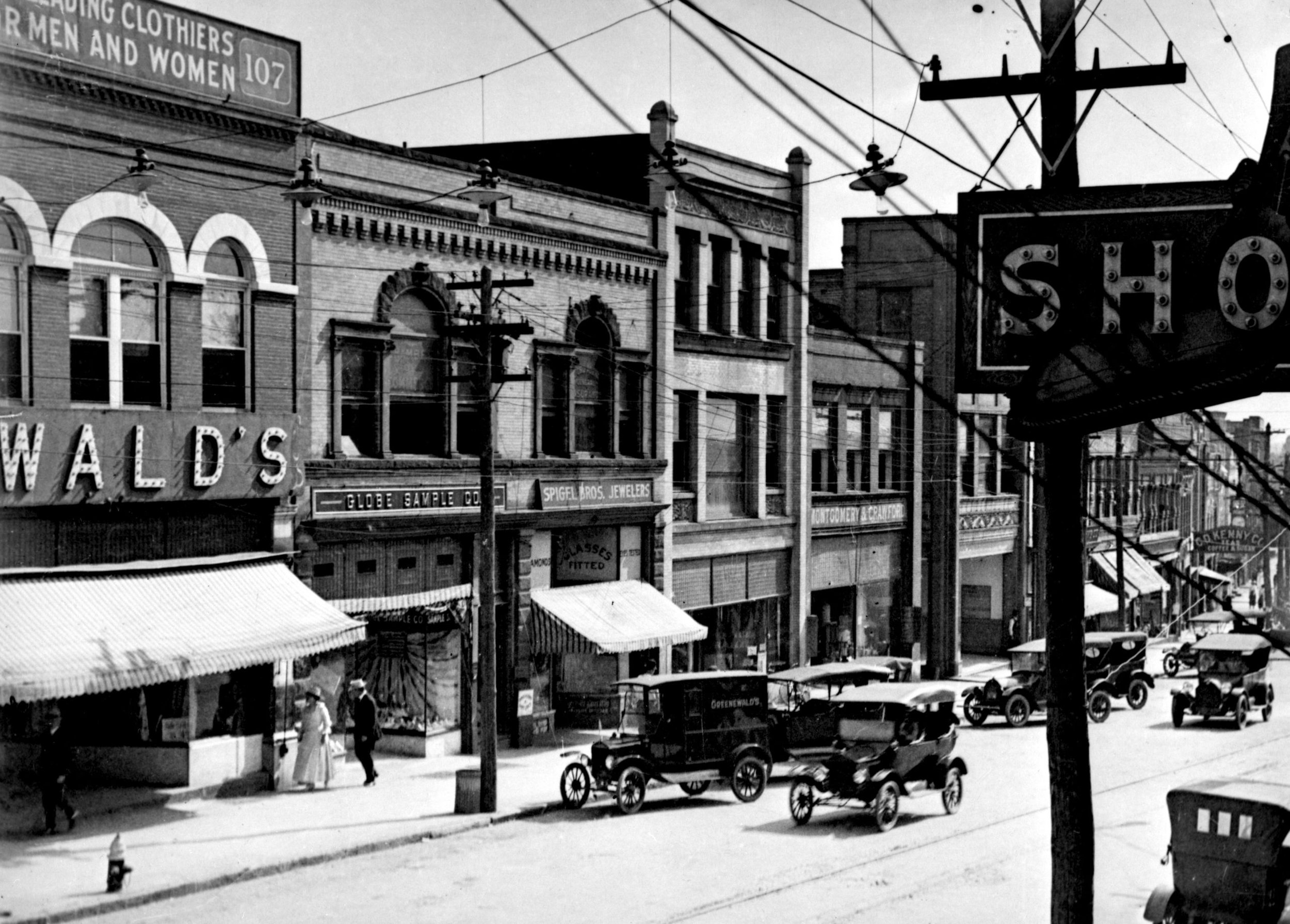

While many iconic buildings surrounding Morgan Square, such as the Andrews Building and Cleveland Hotel, no longer stand today, even more of West Main Street has stood the test of time. The South side of the square, including the former Greenewald's department store and the Leader Building, has been preserved as restaurants, boutiques, offices, and more. Two banks, the Citizens & Southern National Bank on the corner of Magnolia Street, and the Carolina National Bank of Spartanburg on the corner of Wall Street, still face each other today. Both buildings have been restored, into Citizens & Southern Events Center and Bond Street Wines.
Present Day

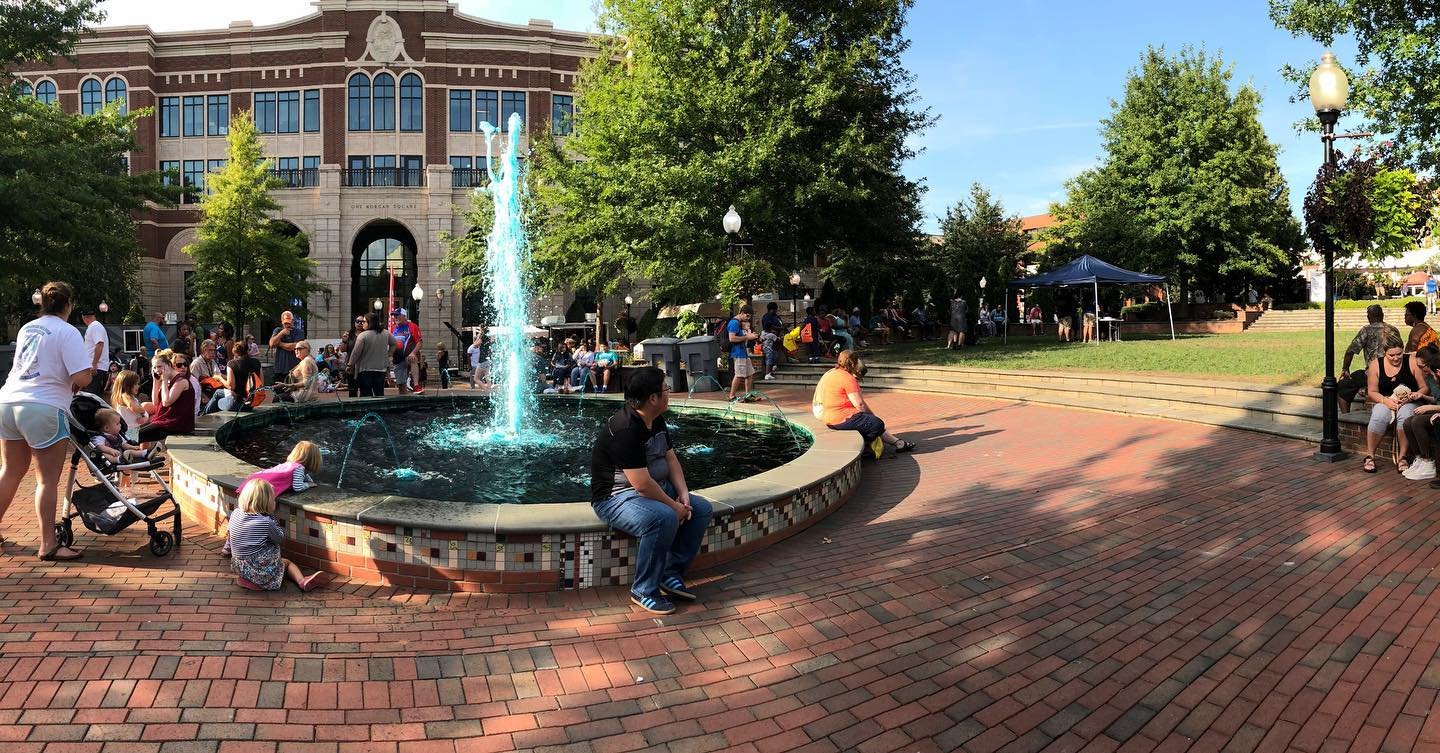


Today, Daniel Morgan Square is a hub of activity once again, as the central point of the Downtown Cultural District, a designation awarded by the S.C. Arts Association in 2015.
Throughout the week and year, find live concerts on the square, a variety of free and family-friendly events programming by the city, live musicians and artists busking on street corners via Chapman Cultural Center, public art, outdoor dining, a shaded "art park" with benches, wide sidewalks lined with greenery, and more.
Daniel Morgan's statue has returned to his original location at the foot of the square, his gaze facing towards Cowpens National Battlefield.
Even the crosswalks add a dimension of public art, with murals painted by local artists.(Click here for more photos of all three crosswalk murals and their creators. Crosswalk photo at intersection of Wall Street and West Main Street via CCC.) While the square itself focuses on pedestrian events, there is no shortage of parking downtown!
More than 3,000 parking spaces can be found in garages and public parking lots. In 2020, the stretch of West Main Street from Church Street to Magnolia Street was closed to vehicular traffic, to allow for better social distancing and outdoor dining during the COVID-19 pandemic. The resulting outdoor gathering space promotes a pedestrian-focused downtown.
What's Next for Morgan Square?
The temporary street closure was extended for one year by City Council in August 2021, with plans to reassess in the future how to improve the functions, programming, and physical features of the square. (Click here for a behind-the-scenes podcast episode on incorporating Morgan Square and its potential uses into downtown's future.)Throughout downtown Spartanburg's many changes, one entity remains the same- Morgan Square is the hub of activity at its center. Stay tuned for more updates in the future on Morgan Square's evolution.






